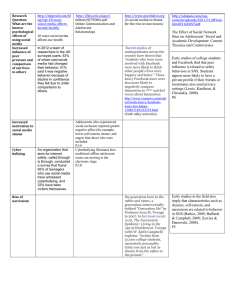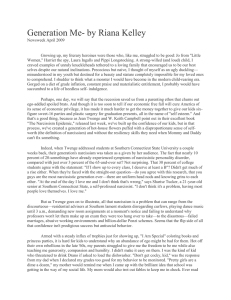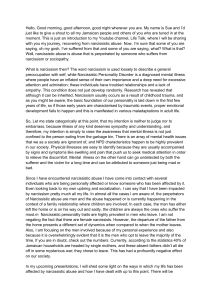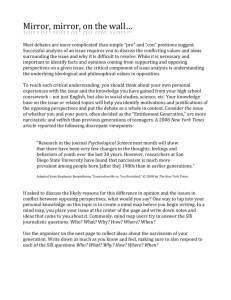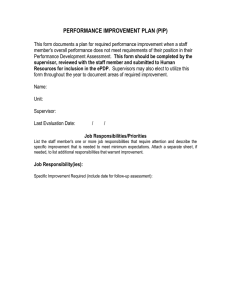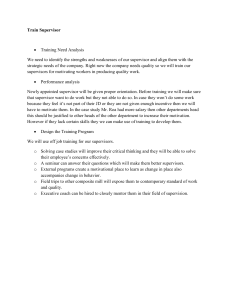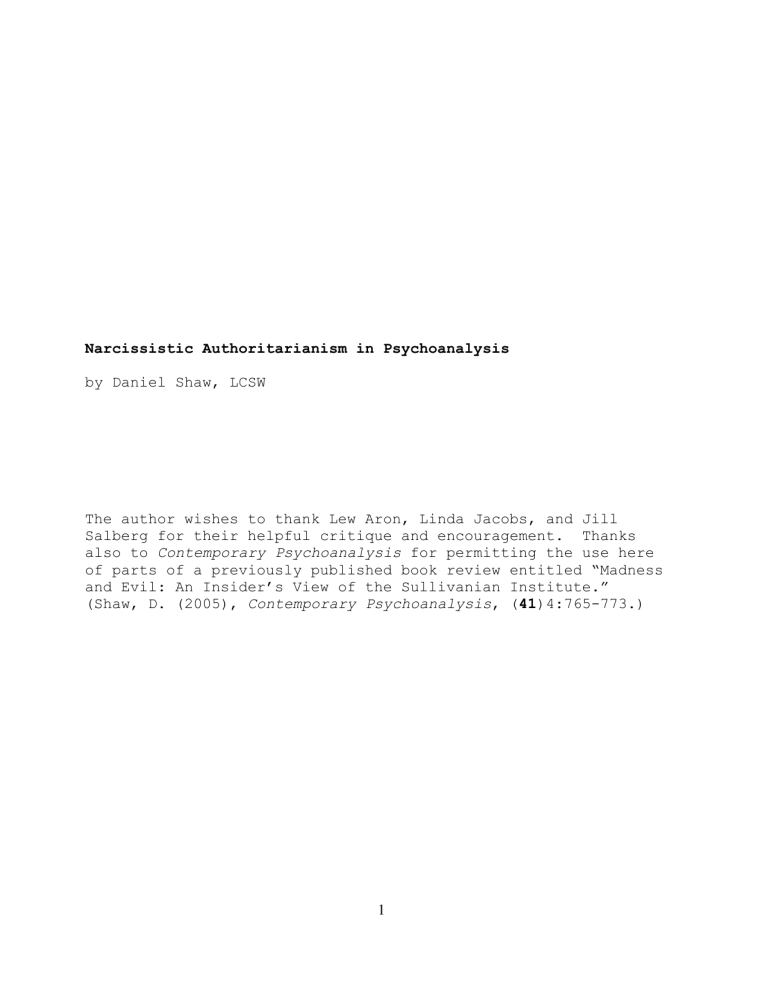
Narcissistic Authoritarianism in Psychoanalysis by Daniel Shaw, LCSW The author wishes to thank Lew Aron, Linda Jacobs, and Jill Salberg for their helpful critique and encouragement. Thanks also to Contemporary Psychoanalysis for permitting the use here of parts of a previously published book review entitled “Madness and Evil: An Insider’s View of the Sullivanian Institute.” (Shaw, D. (2005), Contemporary Psychoanalysis, (41)4:765-773.) 1 Some time ago I played, for a psychoanalytic study group of which I am a member, a comedy sketch, recorded ages ago, in which Elaine May and Mike Nichols portray a psychoanalyst and her patient. Having had a good laugh each of the numerous times I have listened to this sketch over the years, I gleefully, and as I now know naively, imagined my typically serious and scholarly group uncharacteristically doubled over, wiping tears of laughter from their eyes, enjoying a good joke on us all. In the sketch, the patient (Nichols) informs May, his analyst, that in the following week he will have to miss the last of his five sessions per week, since it is Christmas Eve and he plans to be with his family that day. Instantly shattered by the news of her patient’s plan to desert her, May attempts to maintain her analytic stance and mask her spiraling self-fragmentation by demanding that her patient explore, be curious about, reflect on and associate to his need to miss his session. In the face of his insistence that he just wants to be with his family on Christmas Eve, the analyst begins to weep quietly, then to sob in despair, then to scream with rage. Unable to help her recompensate, the patient quietly retreats, wishing her a Merry Christmas, as the analyst continues to unravel. When I turned off the recording, I faced a silent group, with some members 2 finally confessing to a sense of excruciating anxiety while listening. There was little further discussion. quickly to the material we had planned to discuss. parlance, I had bombed. We moved on In showbiz Though unable to articulate at the time why the sketch repeatedly cracks me up, I can now say that for me, it helps to laugh about the ever present, always not fully analyzed narcissism of the psychoanalyst -- that is, to laugh at it, but not to laugh it off. Narcissism is a problem for our patients, but it is just as much a problem for the profession of psychoanalysis and for every psychoanalyst. It is a problem that has shadowed our profession from the beginning, and it is a problem that our profession still struggles to address adequately. As analysts, we have long been concerned with our patients’ narcissism, and as teachers and supervisors, with narcissism in psychoanalytic candidates (e.g., Brightman, 1984-85). But it is increasingly the case (Hoffman, 1998; Cooper, 2004) that our narcissism as analysts, teachers and supervisors occupies the field of our observation. In this paper I will further explore aspects of the analyst’s narcissism and discuss the connection between narcissism and authoritarianism, especially as it pertains to psychoanalytic training. I will discuss authoritarianism in the 3 context of individual supervision; and go on to discuss how narcissistic authoritarianism can become malignant and infect therapeutic communities. Professional Narcissism Freud formulated his conceptualization of narcissism in 1914, and proceeded to enact some of its more problematic aspects -- by deeming himself the only analyst not in need of an analysis by another analyst; by setting up a book of rules for the analytic process which he exempted himself from following; and by marginalizing innovative followers and favoring those whom he could more easily control. Authoritarian control and suppression of dissent may have seemed, at the time, like necessary means to the crucial end of establishing psychoanalysis as a profession, but in the long run these methods have proven ineffective. To the contrary, Balint’s (1968) portrayal of the banishment of Ferenczi from the analytic community as a trauma to the profession still remains relevant. Although it is increasingly more likely in our professional publications and conferences to see rival psychoanalytic schools seeking common ground, years of rampant factionalism and internecine power struggles, along with authoritarian, incestuous training systems (see Levine and Reed, 2004), have substantially contributed, I believe, to the 4 embarrassing fact that the majority of the public here in the United States no longer has a clue as to what we mean when we say “psychoanalysis.” The worst potential of narcissism, for which we reserve the term “malignant,” was fortunately not realized by Freud, whose work, in spite of his imperial tendencies and some serious mistakes, has nevertheless been profoundly generative. But because the psychotherapist is a potent transference figure -not a parent, not an Oracle, not God Almighty, but, for many patients, something like all three -- it is within our power, in a worst case scenario, to gain almost total control over our patients and/or supervisees, and, in the name of psychotherapy and with the power invested in us, control and exploit them for the sheer narcissistic gratification of it. The abuses of power therapists are capable of, in training and clinical situations, and the damage done to students and patients, should not be underestimated. We pay a steep price as a profession, both in terms of the vitality and integrity of our training institutions and in terms of maintaining the public trust, when we do not attend to these problems adequately. Even more importantly, we have a moral imperative to protect students and patients from abuse, to “do no harm,” and this means that we 5 must address these problems where they begin, in the training of our candidates, and in the training of our teachers and supervisors. I link the presence of these abuses to the lingering presence of narcissistic authoritarianism in our profession. Before presenting examples of such abuses, I will offer my view of narcissism and of the connection between narcissism and authoritarianism. Pathological and Malignant Narcissism The pathological narcissist1, in my view, is a person obsessed with matters of superiority and inferiority, in both the moral and the material spheres. Of course everyone is concerned with these matters to an extent - no one is without some vanity, shame, pride, envy and desire for control. The degree of obsession with these matters, its pervasiveness, and the behaviors employed to maintain the sense of superiority, are the 1 I have elaborated these ideas in a previous work entitled “Traumatic Abuse in Cults: A Psychoanalytic Perspective” (2003). The following authors have influenced my formulation of pathological narcissism: Rosenfeld (1964) and the modern Kleinians of London profiled by Schafer (1997), and also Fromm (1964), Kernberg (1985), Kohut (1966, 1971, 1972, 1976) and Josephs (1992). 6 chief factors which determine when these concerns become pathological. The pathological narcissist maintains a tight grip on a brittle, delusional sense of omnipotent superiority as a defense against deeply repressed shame, and feelings of inferiority and envy, which have typically been traumatically instilled and reinforced in the family of origin. The pathological narcissist has been the child of a pathological narcissist, and has developed a profound unconscious identification with the aggressor parent. Unconsciously, the pathological narcissist seeks repeatedly both to expel, and to induce in those around him, the sense of shame and inferiority that has been instilled in him, in an effort to externalize and disavow the toxic shame within – a process that Benjamin (2004) and Davies (2005) have referred to as “passing the hot potato.” This compulsive disavowal and externalization of shame can reach the level of what I would call a narcissistic psychosis, in which the pathological narcissist comes to believe in his unquestionable righteousness, viewing those who disagree or challenge him as hostile, cruel, crazy, ignorant, and/or morally repulsive. Because the pathological narcissist believes he is always right, never wrong, those who have any conflict or grievance with him 7 are kept on the defensive because, according to the pathological narcissist, they are always wrong, never right. The pathological narcissist portrays his opponents and rivals as crazy, inferior, and/or as morally reprehensible. The obsession with unassailable, unimpeachable perfection represents the narcissist’s desperate need for control and is the link between narcissism and authoritarianism. The authoritarian’s oppressive demands for submission are based on the pathologically narcissistic need to maintain omnipotent control and superiority. Authoritarianism, like pathological narcissism, is based on defining others as inferiors and, through whatever control methods are possible, maintaining them as such. Pathological narcissists use a kind of reverse Fairbairnian moral defense (Fairbairn, 1952): they give someone else all the burden of the badness, and always claim the moral high ground for themselves.2 The naked, raw dependency displayed by the analyst in the sketch with Elaine May is precisely what the pathological narcissist is desperately defending against. 2 The pathological I am developing this formulation more fully in a future paper entitled “A Family Tragedy: Pathological Narcissism and the Destruction of Intersubjectivity” (submitted). 8 narcissist, having suffered early severe trauma in connection with dependency issues, is terrified of his dependence. Dependence has come to mean to him that, to his great shame, he is despicably weak, not perfect, not omnipotent. To solve the problem of his mortifying dependence, he induces dependence in others -- his partner, or children, subordinates, students, supervisees, or patients. He achieves this by using his position of authority to set himself up as the ultimate judge, proclaiming those he seeks to control to be either pitiable (and thus redeemable by the pathological narcissist) or contemptible (and thus dispensable). With others who might be less readily influenced he gains control and induces dependence through seduction, or displays of grandiose magnanimity, switching only later, when his omnipotence is questioned in any way, to belittling and shaming. He assumes infallible righteousness and dispenses favor or disfavor, leading others to base their selfesteem on his judgment of them. By provoking and cultivating in others the sense of moral failure and inferiority, the pathological narcissist, manically denying his own shameful dependence, bolsters his delusion of omnipotent self-reliance by projecting his contemptible dependence into others. 9 While not all narcissists function as authoritarian figures, I believe narcissism always underlies authoritarianism, in which an authority figure views himself as always deserving of devotional attention and submission from those around him. Authoritarian figures, in accord with their pathological narcissism, justify interpersonal acts of deception, intimidation, coercion, suppression and exploitation because they believe in their omnipotent righteousness. For them, the end (maintaining delusional omnipotence as a defense against unbearable shame and dependence) justifies any means. I distinguish the pathological narcissist from the malignant by the tendency in the latter toward sociopathy, the ability to commit and justify criminal acts such as sexual violations, robbery, blackmail, assault and murder. Like the malignant narcissist, the pathological narcissist is often cruel, but will stop short of being criminal. Everyday Narcissistic Authoritarianism While there have been numerous examples of pathological and malignant narcissism in psychotherapy communities, far more common are minor intrusions of the analyst’s narcissism in his role as teacher and supervisor. I focus on these everyday examples of minor narcissism in supervision because I believe 10 they are ubiquitous and not adequately examined. The examples I will give are meant to show how vestiges of narcissistic authoritarianism in psychoanalytic training continue to haunt our training situations, in spite of theoretical and cultural shifts away from authoritarianism. While the supervisors in the following examples were trained in the 60's and 70's, by the late 90's they were known for their connections to contemporary self psychology, intersubjectivity and relational theory, which is to say that their theoretical schools are not associated with the more orthodox schools in which authoritarianism might be expected. The incidents I will recount exemplify small lapses in otherwise constructive supervisory experiences, and they occurred against the background of the supervisors’ considerable generosity, intelligence and dedication. Yet when disruptions like these occurred for me and for my fellow candidates in training, and they often did, we felt confused, disconnected, intimidated and ashamed. This tradition in psychoanalysis, of bullying, shaming, and intimidating (whether mild or severe), and refusing to take responsibility and apologize for errors, has roots that go back as least as far as Freud and Dora, a treatment now widely perceived as misattuned and insensitive (Mahony, 1996; Appignanesi and Forrester, 1992); and to the disagreements 11 between Freud and Ferenczi (see Berman, 2004, chapter 1). I believe my supervisors had taken far more of this sort of thing from their analysts and supervisors than they were dishing out, but now and then, the occasional flashback would surface, and I would then be treated to a narcissistic lapse, a taste of what it was like in the “olden days.” In addition to issues of trans-generational transmission of narcissistic behaviors, analysts of course bring their own history of narcissistic vulnerability to the situation. Analysts are often fulfilling deeply cherished, idealistic aspirations in choosing their profession, aspirations that transcend narcissistic concerns regarding power and prestige. The desire to help, to be loving, caring, understanding, and healing are expressions of altruism that many analysts value highly. Many of us are continually moved and grateful to be able to witness the growth and change process in those we help. Yet along with these kinds of motivations can be found more selfish ones, which I believe are quite common. Among these would be the use of our professional status as a means of establishing ourselves as “the sane, healthy one,” usually in defense against a parent’s or sibling’s projections of craziness. We may have needed to distinguish and differentiate ourselves from a crazy parent; or 12 we may be driven to rescue people successfully because rescuing a family member was impossible. We may be seeking to gain the higher moral ground in a power struggle happening in real time with significant others and/or with archaic internal objects. We may be seeking to acquire virtue as helpers in an effort to extinguish a sense of worthlessness. Certainly the motives for our choice of profession are complex and overdetermined, and always include to some degree the fulfilling of our narcissistic needs. The acquisition of prestige, power and control is usually somewhere in the mix, even in the face of highly effective assaults on our power, control and prestige from the insurers and their beloved behavioralists. The various kinds of personal historical factors, such as those mentioned above, that influence our choice of profession play a crucial role in determining what our narcissistic vulnerabilities are, which in turn determine where we fall on the authoritarian continuum in terms of our work. professionals without assuming authority. We cannot be Professional narcissism becomes problematic when it drives us to seek power and control by becoming authoritarian -- i.e., infallibly righteous, and controlling by means of belittling, condescending, intimidating, blaming and shaming. 13 The more narcissistically vulnerable one is, the more potential there is for authoritarian control to be employed defensively. As analysts, teachers and supervisors, we all struggle, more or less, with (at least) the following four areas of narcissistic vulnerability, any one of which could lead to authoritarian control behaviors as we attempt to establish our authority as teachers and supervisors: 1) the temptation to exhibit our superior expertise and power so as to invite idealization and defend against our own anxieties about inadequacy; 2) envy, competitiveness and the fear of being surpassed; 3) the need to be admired and to feel indispensable, along with the fear that we will be rejected (excruciatingly expressed by Elaine May in the comedy sketch); and 4) concerns about our reputation, especially in institutional situations. Regardless of the supervisor’s theoretical orientation, the potential always exists for these vulnerabilities to emerge in the supervisory process. Such vulnerabilities can engender in the supervisor narcissistically defensive behaviors, such as exhibitionism, intimidation and/or shaming, which are behaviors that assert the supervisor’s superiority and promote the supervisee’s sense of inferiority and dependence. 14 Whether the supervisor sees her role as that of an objective, didactic expert, as in the classical tradition, or as an embedded participant, as in the contemporary relational school (Frawley-O’Dea and Sarnat, 2001), the above general narcissistic vulnerabilities, and many that might be more individually idiosyncratic, will inevitably emerge in supervisory work, even if only to the mildest degree. Everyday Narcissism in Psychoanalytic Supervision Let me offer two examples of what I think of as more or less typical, everyday kinds of authoritarian supervisory moments. I completed my MSW in 1996, and my analytic training in New York City in 2000. My supervisors were well seasoned, highly intelligent, sincerely dedicated psychoanalysts, with more or less the same narcissistic vulnerability as most humans. By no means would I consider either of these supervisors to be pathologically narcissistic. Nevertheless, I examine here moments in my work with them when the line between authority and authoritarianism was crossed, suggesting the presence of narcissistic issues in the supervisor. Supervisor 1: In my second year of analytic training, I spent most of a weekly supervision session bristling but accommodating to a supervisor I found condescending and didactic. 15 “Speak in short, precise phrases,” she told me one day, and she demonstrated how she thought analysts should speak. I have never much cared for the stereotypical ways that analysts sometimes speak (sounding too much like Elaine May in the comedy sketch), and I wasn’t planning to emulate such stereotypes. Additionally, I was reasonably certain that my supervisor didn’t always practice what she preached, and that she probably prattled on and on too, at times. head. Saying nothing of any of this, I nodded my I didn’t want to be a resistant, narcissistic candidate – as candidates who are not sufficiently submissive are often labeled. We finally had a real argument in a later supervisory session where, in response to my disclosure of some countertransference difficulties I was having, she took out a book and read a whole page about analytic technique to me. Discouraged and angry that my countertransference struggles seemed of no interest to her other than as technical errors to be intellectually disposed of, I expressed my frustration. She was astonished, and admonished me for not taking in the bountiful good things she was giving me. A week later, I tried to patch things up by mentioning that I sometimes found it difficult to relate to authority figures. She responded with a nod, at most, 16 and proceeded as though nothing had happened. We never discussed it further. My chief impression of our work together over the course of a year was an internalized admonition about being long-winded, and I’ve kept it in mind all these years. But I question myself at times as to how much I control my speech for my patients’ benefit, and how much control stems from a “thought police” mind set which I reject but which nevertheless creeps in, shaming me in spite of myself. The need to be admired, feared and imitated is, in my view, an expression of the supervisor’s narcissism. A supervisor who presents herself as the model for how the supervisee should speak and think is assuming that the supervisee is looking for the supervisor to be an idol to imitate. On the contrary, I believe most supervisees are looking for support and encouragement to develop and grow as persons and analysts in their own right. If we offer supervisees technical and theoretical models based on our own biases and preferences, and of course we always do, I think we at least owe it to them to acknowledge our biases and preferences, explain to some extent the basis for our preferences, and encourage them to form their own. keeping this information mystified eludes me. 17 The value of Many institutes now elicit evaluations of supervisors from supervisees, no doubt sincerely hoping to promote collegiality rather than indenture. Yet I believe it is rare for a supervisee to disclose their critique of a supervisor fully. Supervisees in this situation often feel themselves to be, and possibly actually are at risk of being diagnosed as narcissistic (note the projection) and judged by their institute as difficult, in need of further analysis, and so on. for many. Compliance is the safer route Defiance risks punishment by tarnishing the supervisee’s reputation within his institute, which could mean losing opportunities for referrals, and for playing significant roles in the institute after graduation, such as becoming a training analyst there, teaching, supervising, serving on the board of directors, etc. Supervisor 2: I was presenting a patient, in my final year of training, whom I liked a great deal. I was speaking of a struggle I had been having with listening to her, connected to my sense that she was defending against a great deal of shame. As a result, she seemed to use at times a very contrived, theatrical persona when she communicated with me, a persona that stood in sharp contrast to what seemed like another aspect of her which emerged in some sessions, a more related, reflective, alive 18 version of her. My patient and I had begun to be able to talk about this, and I was relating this to my supervisor. I repeated a remark I made to the patient, to the effect that I found myself more engaged and connected to the real person than to the theatrical persona. Without waiting to learn how my patient reacted, my supervisor colored, stiffened and said quite sharply, in a tone of rebuke I don’t think I had heard since about 7th grade: “And who do you think you are to have said that to her?” I was a fourth year candidate, and tired of being afraid of my supervisors, no matter how much I was depending on their support, so I raised an eyebrow or two and looked quizzically into my supervisor’s eyes, as if to say, “you aren’t really taking that tone with me, are you?” standoff, he softened. After a tense momentary The supervisor went on to be less reproachful and more facilitative, but we did not return to or try to work through what happened until the following week, when while reporting on the same patient, I let my supervisor know that I was aware, during my session with the patient subsequent to my supervision, of imagining my supervisor negatively judging all of my interventions, including “uh huh” and “mmm hmmm.” Without hesitation, my supervisor said that he was having a stressful day the week before and that I should go ahead and work 19 without imagining him disapproving of me. Although I was the one initiating all the processing of what had happened, I appreciated his concession, and we got on pretty well from there. And yet, I would have to say that my trust was somewhat shaken from that point on. This supervisor was willing to be accountable for his shaming, intimidating behavior, but only after I brought it up, and only nonchalantly, and with no apology. It is of course entirely expectable that one might slip up and err as a supervisor by being too didactic, or reacting hastily in a shaming way. This can and does happen with most supervisors, sooner or later. But as I see it, the supervisor then has the responsibility to process with the supervisee what has happened, and to repair the disruption. In the absence of such willingness to process, the supervisee, who is likely to be vulnerable to a shaming and intimidating supervisor, may develop more anxiety about disapproval than would already be normally present. His work as he presents it could then become organized around receiving the supervisor’s approval, around meeting supervisory requirements which are subjectively biased toward the supervisor’s particular theoretical and technical preferences, and which are shaped by the supervisor’s narcissistic concerns. 20 The supervisee learns to develop a “false supervisee self” based on compliance. In my view, this also greatly increases the chances that the supervisee will go on to elicit similar results with his patients. In considering the examples I have presented, I have avoided attempting to identify the specific narcissistic vulnerabilities these supervisors might have been influenced by, because I have no idea what they might be, and even if I did, it would be inappropriate to reveal that information, even speculatively. What is relevant to this discussion is that the presence of authoritarian behaviors in these supervisors, such as their use of shaming and intimidation to promote compliance, indicates a link between narcissism and authoritarianism. In both cases, the behaviors I describe could be means by which these supervisors unconsciously sought to raise the candidate’s anxiety about the supervisor’s approval, a situation that might give the supervisor a feeling of greater power and control. Because candidates are typically investing so much in becoming analysts, it is easy for them to base their self-esteem as people on their performance as rated by their supervisors. This is especially true given the amount of power, both personal and professional, candidates typically perceive supervisors as having. 21 The fiction that our supervisors and training analysts can be assumed to be free of narcissism potentially sets up a no-win situation for the candidate, who then always has to “hold the hot potato” in a conflict because the supervisor is always “right,” and the candidate is always being “narcissistic.” Here is where supervisors and supervisees must learn to draw the line between authority and authoritarianism, or risk turning training into indoctrination. Suppressing individuality and creativity in candidates in favor of compliance and accommodation strikes me as the Orwellian version of psychoanalysis, of which we should all be very afraid. As supervisors, we have the opportunity, by being comfortable with and acknowledging our fallibility, to model to our supervisees and students our ability to negotiate and regulate our narcissistic vulnerabilities, thus potentiating in turn the supervisee’s release from undue shame and fear of imperfection, and aiding the development of a sense of unique professional identity. By so doing, we protect ourselves, and our supervisees and patients, from the danger of authoritarian domination, indoctrination, and theoretical dogmaticism, which are hallmarks of the narcissistic need for omnipotence in the psychoanalytic training context. 22 Malignant Narcissistic Authoritarianism Having looked at the ways everyday narcissistic authoritarian behaviors occur in psychoanalytic supervision, it behooves us to be familiar with just how destructive severely pathological narcissistic authoritarianism can become in psychotherapy communities, or among therapists influenced by authoritarian teachers. In such cases, a psychotherapy community can become a cult -- isolated, paranoid and with the potential for devastation. What follows is an example of how psychotherapists have been influenced by a pathologically narcissistic, authoritarian religious leader. In this example, only one of many I might include if space permitted, we see the tendency toward sociopathy in malignant narcissism. Siddha Yoga is a religious organization that teaches that meditation and worship of the Siddha Yoga guru (currently, an Indian woman in her early 50’s known as Gurumayi) constitute the path to spiritual enlightenment, in which one may purify and cleanse one’s bad karma, and come to experience God within oneself while recognizing and welcoming God in others. Siddha Yoga is a group that attracts a wealthy clientele, including celebrities, socialites, performers and academics, in spite of the fact that the extensive history of sexual and other abuses 23 perpetrated by the leaders of this group is well documented in a New Yorker article by author Lis Harris (Harris, 1994), and in various online groups where former members give testimony about the group (also see Rodarmor, 1983). Less well known is the influence of Siddha Yoga on mental health practitioners. The Siddha Yoga organization began holding annual conferences for mental health professionals in the mid1980’s, and were still doing so to my knowledge as late as 1997. Though not yet a mental health professional, I attended the first two of these conferences during a period of time when I was a participant in the Siddha Yoga community. I recall the presence of several hundred practitioners, gathered in a retreat facility in upstate New York for a full day seminar, conducted by staff members of the organization, and with guest speakers such as Dr. Paul Muller-Ortega, now a professor of religious studies at the University of Rochester. These seminars, as I know from personal contact with their organizers and as an eye-witness, primarily served to encourage mental health practitioners already practicing Siddha Yoga to invite their patients to get involved. Therapists were taught to display altars with pictures of Gurumayi in their offices, and were advised on how to talk about the benefits of their own use of Siddha Yoga meditation when 24 their patients noticed the altars and made inquiries. Also in these programs, therapists who were Siddha Yoga devotees shared their experiences, in coached presentations, of how Siddha Yoga transformed their therapy practices, how they shared Siddha Yoga with their patients and how it transformed those patients’ lives. These therapists had brought groups of their patients to the retreat facility to meet Gurumayi, and received special attention from Gurumayi for their recruitment efforts. Therapists not already involved in Siddha Yoga were actively recruited at these conferences, in which they were led through various meditation exercises, and finally given a special audience with Gurumayi, who made a regal impression in her bright red silk robes, seated on a throne before which the attendees were invited to prostrate themselves at her feet. In addition to encouraging devotee therapists to recruit their patients into Siddha Yoga, Gurumayi referred many of her devotees, whether they asked for referrals or not, to other devotees who were mental health professionals. According to several of these professionals I spoke with, who eventually severed their ties to Siddha Yoga, Gurumayi then solicited reports from these devotee therapists about those she had referred, and discussed details of their treatment with these 25 therapists in the presence of other members of her entourage, often in mocking tones.3 Gurumayi was engaged in a long vendetta against her brother, a rival Swami named Nityananda, throughout the 1980’s and beyond (Harris). During this time, staff members of Gurumayi’s organization were ordered by her to organize local Siddha Yoga followers to develop ways to harass her brother. The most notorious of these incidents, in which skunk oil was thrown at audience members listening to a lecture by Nityananda, was executed by a licensed psychologist, one of those whom Gurumayi had often referred members to see for psychotherapy. Gurumayi and her closest advisors perpetrated, justified and condoned many other illegal and unethical behaviors, and persuaded followers, including mental health professionals as in 3 In 1995, I and others who knew of these practices contributed information about the conferences to an online discussion group about abuses in Siddha Yoga. I have been told by a participant that in the last conference, held in 1997, therapists were specifically warned against recruiting patients. Nevertheless, I continue to receive inquiries, as recently as 2004, from psychotherapy patients who have observed a picture of Gurumayi in their therapist’s office. 26 the above example, to do the same. The malignant narcissist acts in conformance with the underlying belief that she (in this case, the Siddha Yoga guru) is perfect, superior and ultimately entitled, and therefore any means will always justify the end the end being the fulfillment of the pathological narcissist’s every wish, thereby perfection. maintaining the delusion of omnipotent In authoritarian communities, this goal becomes the shared goal of the followers, even though this invariably entails the betrayal of their own moral values, as in the case of therapists who dissociatively overlooked the flagrant ethical violation of recruiting their patients into Siddha Yoga. Followers of a pathological narcissist assume a masochistic position, becoming pathological narcissists by proxy. Through dedicating themselves to the leader in total submission, and by taking on the leader’s goals (typically grandiose plans to transform the world that would simultaneously enrich and empower the leader), the follower partakes of the pathological narcissist’s omnipotence via the means of masochistic submission and devotion.4 4 This dynamic was well elaborated by Erich Fromm (1941) in Escape from Freedom, in which he describes the concept of the Magic Helper. 27 In the last ten years, I have worked often with former members of cults, and have learned of many other authoritarian psychotherapy groups. The problem is all too common, and while some former members have succeeded in actions against practitioners leading to the revocation of their licenses, many of the leaders of such groups have no professional credentials to begin with. To address this problem, we must first develop a greater understanding of the problem of narcissistic authoritarianism, from its mildest to its most pathological forms, and recognize it and study it as an ongoing professional phenomenon which will always require our attention. This chapter, and this book as a whole, are steps toward that goal.5 5 Efforts toward this end are represented as well by recent publications such as Levine and Reed (2003), and Berman (2004). 28 Conclusion Psychoanalysts have struggled since the beginning of the profession to understand their power, and to use their power responsibly and therapeutically. But power is never a simple matter for humans to negotiate -- power is always potentially corrupting. On the one hand, we set ourselves the goal of expanding the freedom of our patients, and on the other hand, we establish training methods that all too often lead to accommodation, compliance and conformity in our trainees. As I have attempted to show, it is unconscious, disavowed narcissism in psychoanalysts that engenders authoritarianism, which is a corruption of power that is characterized by the employment of interpersonal strategies for domination and control as a means of defending against narcissistic vulnerability. 29 It is in no small measure the postmodern trend toward the interrogation of authority that has begun to resuscitate and reinvigorate the psychoanalytic profession. It is this willingness to level with ourselves, to confront our own professional narcissism and question all our assumptions about our authority and the use of our power, that may yet rescue psychoanalysis from the brink of obsolescence -- the perilous position our own professional narcissism has, to a great extent, helped to put us in. Daniel Shaw, LCSW 850 Seventh Ave., Ste. 906 New York, NY 10019 Shawdan@aol.com References Appignanesi, L. and Forrester, J. (1992). Freud’s Women. New York: Basic Books. Balint, M. (1968). Regression. London: The Basic Fault. Therapeutic Aspects of Tavistock Publications. 30 Benjamin, J. (2004). “Beyond doer and done-to: an intersubjective view of thirdness.” Psychoanalytic Quarterly, 63:5-46. Berman, E. (2004). Impossible Training: A Relational View of Psychoanalytic Education. Brightman, B. (1984-85). Hillsdale, NJ: The Analytic Press. “Narcissistic issues in the training experience of the psychotherapist.” International Journal of Psychoanalytic Psychotherapy, 10:293-317. Davies, J. M. (2005). “Whose bad objects are we anyway? Repetition and our elusive love affair with evil.” Psychoanalytic Dialogues, 14(6):711-732. Hoffman, I. (1998). Process. Ritual and Spontaneity in the Psychoanalytic Hillsdale, NJ: Cooper, S. (2004). The Analytic Press. “State of the hope: the new bad object in the therapeutic action of psychoanalysis.” 14(5):527-551. 31 Psychoanalytic Dialogues, Fairbairn, W. R. D. (1952). Psychoanalytic Studies of the Personality. London: Routledge & Kegan Paul. Frawley O’Dea, M. and Sarnat, J. (2001). Relationship. The Supervisory New York: The Guildford Press. Fromm, E. (1941). Escape from Freedom. New York: Farrar and Rinehart, Inc. --(1964). The Heart of Man: Its Genius for Good and Evil. New York: Harper & Row, Publishers. Harris, L. (1994), Nov.14). “O Guru, Guru, Guru.” The New Yorker, pp.92-109. Josephs, L. (1992). Character Structure and the Organization of the Self. New York: Columbia University Press. Kernberg, O. (1985). Borderline Conditions and Pathological Narcissism. Northgate, NJ: Jason Ironstone, Inc. Kohut, H. (1966). “Forms and transformations of narcissism.” Journal of the American Psychoanalytic Association 8:567-586. – (1971). The Analysis of the Self: A Systematic approach to the Psychoanalytic Treatment of Narcissistic Disorders. New York: International Universities Press. –(1972). “Thoughts on narcissism and narcissistic rage.” Psychoanalytic Study of the Child, 27:360-400. 32 – (1976). “Creativeness, Charisma and Group Psychology: reflections on the self-analysis of Freud.” In Freud: The Fusion of Science and Humanism: The Intellectual History of Psychoanalysis, J.E. Gedo and G.H. Pollock, eds. New York: International Universities Press. Levine, H. and Reed, G.. eds. (2003). “Problems of power in psychoanalytic institutions.” Psychoanalytic Inquiry, (24)1:1139. Lifton, R. J. (1999). Destroying the World to Save It. Aum Shinrikyo, Apocalyptic Violence, and the New Global Terrorism. New York: Henry Holt and Co., LLC. Mahony, P. (1996). Press. Freud’s Dora. New Have, CT: Yale University Mitchell, S. (1988). Relational Concepts in Psychoanalysis: An Integration. Cambridge, MA.: Harvard University Press. Pearce, J. and Newton, S. (1965). The Conditions of Human Growth. New York: Citadel Press. Racker, H. (1968). Transference and Countertransference. York: International Universities Press. New Rodarmor, W. (1983, Winter). The secret life of Swami Muktananda. CoEvolution Quarterly (reprinted by permission of CoEv Q in 2 issues of CAN/FOCUS News, April-May 1984:5-6; and Summer 1984:56). Rosenfeld, H. (1964). “On the psychopathology and psychoanalytic treatment of schizophrenia.” In Rosenfeld, H. (1965). Psychotic States: A Psychoanalytical Approach. London: The Hogarth Press. Schafer, R. (1997). The Contemporary Kleinians of London. Madison, WI: International Universities Press, Inc. Shaw, D. (2003). “Traumatic abuse in cults: a psychoanalytic perspective.” Cultic Studies Review (2)2:101-129. 33 Siskind, A. (2003). The Sullivan Institute/Fourth Wall Community: The Relationship of Radical Individualism and Authoritarianism. Westport, CT: Praeger. Daniel Shaw, LCSW, is in private practice in New York City and Nyack, New York. He is a clinical supervisor at The National Institute for the Psychotherapies (NIP) in New York; faculty at The Object Relations Institute, New York; and a member of the Education Committee of the International Association for Relational Psychoanalysis and Psychotherapy (IARPP). 34
